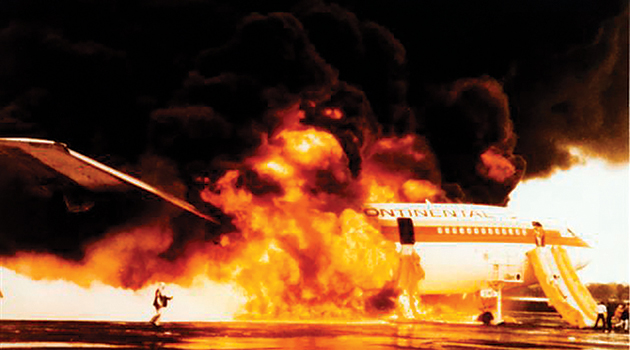 Commercial aircraft crashes are rare, but with some recent incidents my memory went back to the Continental DC 10 crash at LAX. It’s been 41 years and the outstanding LAFD response saved many lives. I visited Captain Bob Engle some years ago who remembered the incident very well. This is one of those incidents where our LAX firefighters actually saved almost 200 people on that airplane because of their rapid response and firefighting and rescue operations.
Commercial aircraft crashes are rare, but with some recent incidents my memory went back to the Continental DC 10 crash at LAX. It’s been 41 years and the outstanding LAFD response saved many lives. I visited Captain Bob Engle some years ago who remembered the incident very well. This is one of those incidents where our LAX firefighters actually saved almost 200 people on that airplane because of their rapid response and firefighting and rescue operations.
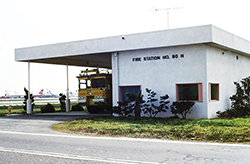 It was Wednesday morning, March 1, 1978. At Fire Station 80, Captain Bob Engle was giving a drill on rescuing passengers from a burning airplane. Captain Engle was an expert in crash rescue firefighting with more than 20 years of experience at LAX. Two miles north of 80’s was a satellite crash station known as 80’s north or “the little house on the prairie.” On duty were Firefighters Jim McJannet and Tommy Kaiser with CB1, a 1968 Walter crash rig carrying 3000 gallons of water and 500 gallons of light water foam concentrate. McJannet was looking out of the station window watching a Continental DC 10 aircraft with 198 people on board and 81,000 gallons of Jet-A fuel taxi to the end of the runway for a take off to Honolulu. At 0923 the jet started down the runway and at 179 miles per hour the two front tires on the left main landing gear blew apart as it passed by 80’s north.
It was Wednesday morning, March 1, 1978. At Fire Station 80, Captain Bob Engle was giving a drill on rescuing passengers from a burning airplane. Captain Engle was an expert in crash rescue firefighting with more than 20 years of experience at LAX. Two miles north of 80’s was a satellite crash station known as 80’s north or “the little house on the prairie.” On duty were Firefighters Jim McJannet and Tommy Kaiser with CB1, a 1968 Walter crash rig carrying 3000 gallons of water and 500 gallons of light water foam concentrate. McJannet was looking out of the station window watching a Continental DC 10 aircraft with 198 people on board and 81,000 gallons of Jet-A fuel taxi to the end of the runway for a take off to Honolulu. At 0923 the jet started down the runway and at 179 miles per hour the two front tires on the left main landing gear blew apart as it passed by 80’s north.
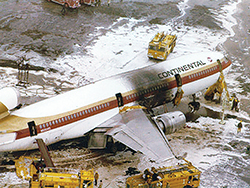
McJannet notified 80’s and OCD, requesting five more task forces and joined Kaiser in the rig which began rapidly accelerating toward the thick black smoke from the plane which had overshot the end of the runway. All of 80’s responded with Captain Engle in the Rapid Intervention Vehicle followed by two more Crash rigs and Engine 80. The plane was resting on its left wing with thousands of gallons of jet fuel burning around the plane. The fuselage was intact as the passengers rushed to the four exit doors on each side of the plane. The crew yelled at the passengers to not open the left side doors because the fire was most severe there. Never-the-less the doors were opened and all the escape chutes were deployed. An elderly couple exited onto the right wing but fell to the ground and were killed. Many of the passengers sliding down the chutes were injured when they reached the ground. CB 1 arrived quickly from the tail of the aircraft and when they were within 150 feet started the foam application onto the ground fire on the right side. As they approached the middle of the aircraft Kaiser and McJannet were startled by the sight of 8 to 12 people all on fire trying to beat out the flames with their hands. McJannet opened up the turret and sprayed it over the burning passengers which instantly doused the flames. McJannet then cleared an evacuation route for the passengers by sweeping the foam turret under the plane. By that time all of 80’s crash rigs arrived and began a full foam operation on the fire. It took all they had to knock the fire down while the crew from Engine 80 under Captain Gerry Halstead entered the foam blanket to begin making rescues. Hand lines were then brought in for final extinguishment. No passengers or crew were found on board. As other fire companies and ambulances arrived from the surrounding area they were deployed into a large rescue and EMS operation involving multiple engine and truck companies and eleven rescue ambulances. Of the 198 passengers and crew only two were killed and more than 43 were transported to hospitals.
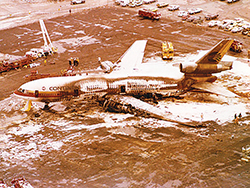 Many letters of appreciation were received by Captain Engle and the LAFD including one from Mayor Bradley, the Airline Pilots’ Association and Continental Airlines. One very touching letter was written on March 11, 1978 by two survivors.
Many letters of appreciation were received by Captain Engle and the LAFD including one from Mayor Bradley, the Airline Pilots’ Association and Continental Airlines. One very touching letter was written on March 11, 1978 by two survivors.
Mr. & Mrs. Al Smithson:
Dear Captain Engle: How does one begin to express gratitude for life? There are no words strong enough to convey our thanks for the miracle of just being here. On March 1st my husband and I boarded the ill-fated Continental plane bound for Hawaii. Minutes later the windows were filled with flame – it seemed inevitable the plane would explode. From then on, our lives were in the capable and courageous hands of your men. My husband suffered no injuries and though I have a fractured back and ribs I feel more than fortunate to be writing this letter. We understand several of the firemen were burned. This distresses us and it is our sincere hope their return to good health will be rapid. We would greatly appreciate your expressing our deepest thanks to all men involved. If there is some way we could be of service, please let us know.
Most Sincerely,
Mr. and Mrs. Al Smithson
This incident was a testimonial to the outstanding work done by our airport firefighters. CB1 was at the crash site and using foam within 90 secondsof the first alarm. The fire was controlled one minute after that and total extinguishment was accomplished six minutes after the crash. All of the injured victims were transported to hospitals in less than one hour after being treated by paramedics on the field.
Retired Engineer Tom G. Harrison donated an awesome plaque commemorating the incident. The inscription reads “Plaque donated by Engineer Tom G. Harrison. Thanks to Capt. Robert Engle of Crash 80 who was in charge of the incident for the photos.” This unusual plaque has a window cut from the fuselage of the DC 10 as the centerpiece. You need to come and see this outstanding work of art at the Hollywood Museum.
—–
DC-10 crash kills 2 at LAX – Article in the Culver City Tribune, March 3, 1978 (edited for this Grapevine Article)
By Karen Davis, Staff Writer
A Continental DC-10 on its way to Honolulu with 197 passengers and crew crashed on takeoff Wednesday killing two passengers and injuring at least 40 others, five of those critically. These were the first fatalities at the LAX proper in its 50-year history. Two tires blew out collapsing the landing gear and causing the plane to skid off the runway, tip over, break the right wing and catch on fire. The entire left side of the plane was burned.
An earlier report from the FAA said there had been voice communication with the pilot, Captain Gene Hershey, who decided to abort the takeoff. Hershey was on his final flight before retiring after 37 accident-free years. “He did a beautiful job,” said one LAX official of Hershey.”He has nothing to be ashamed of. He saved a lot of lives.” She added that the runway was torn up, and it appeared that Hershey had taken exceptional measures to turn the craft around, miss a car rental agency and outer runway markers–just a few hundred feet from busy Sepulveda Blvd.
The two victims, an unidentified man and woman, were found dead at the bottom of the front right wing exit chute, which had caught on fire. Preliminary reports indicate they died while attempting to evacuate the craft. A fire official said flames spread from the left side to the right side of the fuselage, engulfing the slides.
The first fire unit to arrive at the scene was Crash 80, stationed at LAX. “As we left the station we could see a large column of smoke from the north runway. Flames were visible and I requested additional units,” said Captain Robert E. Engle. When the first unit arrived, the left side of the craft was engulfed in flame. No flames reached the cabin of the giant jet, according to a fire department representative. Twenty-five fire rigs with 75 firemen under the command of Division Chief Willis Nelson responded to the scene.
Submitted by Frank Borden

